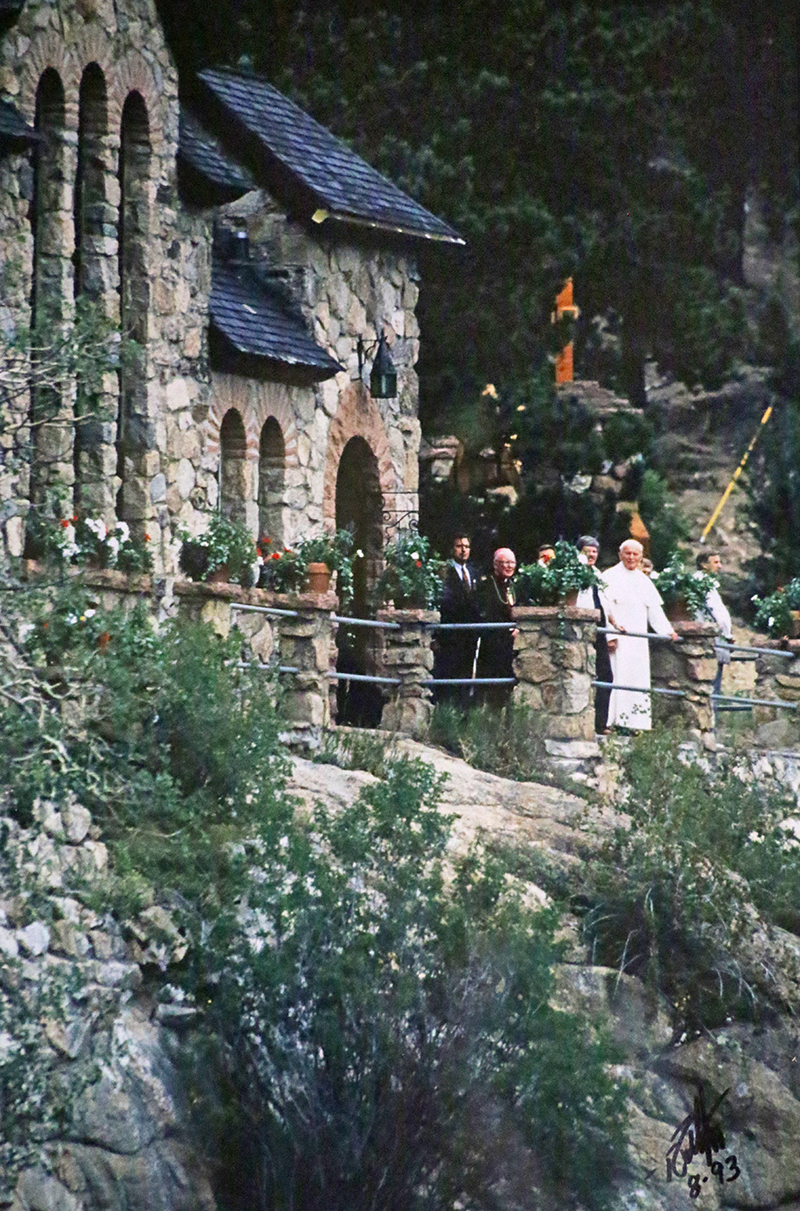Camp St. Malo History
History of the property:
In the early twentieth century, a man by the name of William McPhee owned the land that is now Camp St. Malo. McPhee was a parishioner of the Cathedral parish in Denver, and he often allowed the parish to take kids hiking and camping on his property. During one of those trips, several campers saw a meteorite or shooting star that had appeared to hit the earth. They went looking for it and came upon the Rock that now stands as the foundation of St. Catherine of Siena Chapel. The Rock immediately evoked a reminder of Our Lord’s words to Peter “On this rock I will build my Church.” The chapel would not be built until 1935, and only after struggles with the Colorado Highway Department who wanted to use the rock for road base. St. Catherine of Siena Chapel, also referred to as the Chapel on the Rock, is what stands visible to this day.
William McPhee eventually gave the land to the Archdiocese in a gentleman’s agreement and they were able to build St. William’s Lodge which is one of the two remaining buildings on the property. Many buildings have been built and then destroyed but St. William’s and the Chapel remain.
After the camp had been running for several years, a nephew of William McPhee, tried to take back the land for financial reasons. The Malo family then stepped in, bought the property, and gave it back to the Archdiocese. At that time, it was renamed Camp St. Malo. From there on out, the Malo family was invested in the property and contributed to many building projects on site.
With the help of the Malo Family, Camp St. Malo was able to run from 1935 to around 1980. The camp was originally boys’ camps and then was expanded to include co-ed camps in the 1970s.
In 1984, Camp St. Malo closed to evaluate the facilities and consider expanding ministry opportunities. In 1987 the property reopened as St. Malo Religious Retreat and Conference Center, for a time being run by members of the Christian Life Movement. In 2011, a tragic fire severely damaged the building, necessitating its closure. While the plans for reconstruction were underway, a major flood swept through the property, damaging the land but miraculously leaving the chapel untouched. After the flood, it was decided that the land was too unstable to rebuild upon. Instead, they renovated St. Williams Lodge and opened the property for public visits and the celebration of matrimony.
Historic Site
The Chapel’s important visitor:
In 1993 Denver was blessed to be the host of World Youth Day with Pope John Paul II. While in Colorado, the pope visited Camp St. Malo. On Aug. 13th, St. Malo was closed to the public so that the Holy Father could rest and pray on site. He had lunch, took a nap, hiked up Cabin Creek, stopped to read German poetry on a rock, visited and prayed at St. Catherine of Siena Chapel, and then, much to the consternation of the Swiss Guard and his secret service, visited with the cheering crowd lined up on Highway 7.
The story of the Saints associated with Camp St. Malo:
St. Malo was a Welsh man who became bishop and missionary of Brittany, France. He lived from 520 to 621 and is one of the seven founding Saints of Brittany. He was a disciple of St. Brendan and was consecrated the first Bishop of Aleth. He was compelled to leave the island because of the disorder but returned when his people begged him. At the end of his life, he desired solitude, and so lived out the remainder of his days in pray and penance. Malo’s name may derive from the Old Breton machlou, a compound of mach “warrant, hostage” and lou (or loh) “brilliant, bright, beautiful.”
St. Catherine of Siena was born in 1347 and was the 25th child born to her parents. Many of her siblings did not survive into adulthood. St. Catherine was expected to marry, but through her persistent fasting and pray her parents relented and she joined the Third Order Dominicans. She received many mystical experiences throughout her life which lead her to work for reform in the Church. She died in 1380 and was declared a Doctor of the Church for her influential writings.
Through the Years:
Over the years, thousands of visitors have stopped at the chapel to pray and to enjoy its simplicity and beauty. It is framed against the majestic Mt Meeker – 13,911 feet. In 1999 Boulder County designated the chapel an Historic Site. The tabernacle, the large crucifix, and the sanctuary lamp have been in use in the chapel since the first mass was offered in 1935.
The Archdiocese of Denver recently concluded a restoration project to preserve the beauty and rich history of Chapel on the Rock, the Pope Saint John Paul II trail and a new visitor and heritage center.




